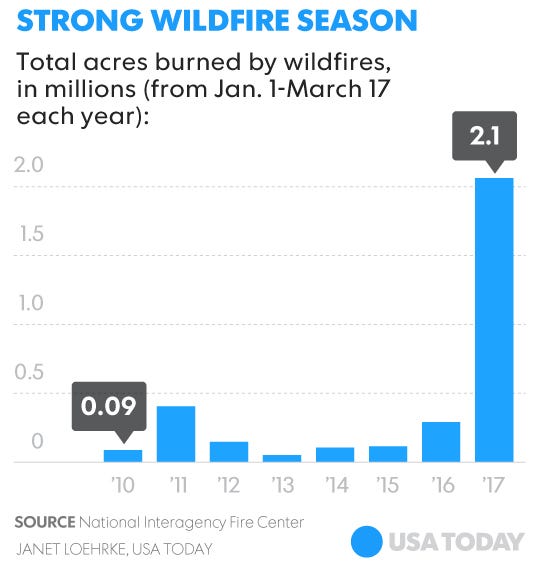U.S. sees furious start to the wildfire season
Wildfires have charred a whopping 2 million acres across the U.S. so far this year, an area larger than the state of Delaware.

It's a gigantic number for so early in the season, roughly 10 times the average and also the most acres burned as of mid-March since 2006, according to spokeswoman Jessica Gardetto of the National Interagency Fire Center in Boise, Idaho.
Many of the blazes have been massive grass fires in Oklahoma and Kansas, which have both set records for number of acres burned in March, Gardetto said.
An Oklahoma truck driver died two weeks ago in Clark County, Kan., due to smoke inhalation from a fire, the Kansas state fire marshal's office reported. There have also been at least seven fire-related injuries, two of whom were first responders.
In Kansas, most fires are started by “controlled” or planned fires that either rekindled or spread out of control, according to Kevin Doel, a spokesman with the Kansas State Fire Marshal's office. (However, the causes of this year's blazes have yet to be determined.)
So far this year, approximately 650,000 acres have burned, Doel said, though that number may change as the fire data are further analyzed.

In parched Oklahoma, drought conditions now encompass three-quarters of the state, the U.S. Drought Monitor said. Oklahoma City has received a paltry 0.01 of an inch of rain so far this month, the National Weather Service said, which is less than 1% of the city's typical March precipitation.
Ongoing warm, dry, breezy weather will bring ideal conditions for fires to spread in Oklahoma on several days this week, the weather service predicted.
Along with drawing hot, dry air out of Mexico, strong south to southwest winds will increase the wildfire threat across the region this week by quickly spreading any small fires that break out over the southern and central High Plains, AccuWeather said.
"The wildfire danger will ramp up on Wednesday with the worst conditions likely on Thursday," according to AccuWeather meteorologist Brett Anderson.
Study: People start 84% of U.S. wildfires
Farther west, the Sunshine Fire, which forced hundreds of people from their homes in Colorado on Sunday, was due in part to tinder-dry conditions there. While March is typically Colorado's snowiest month of the year, "one of the firefighters said it feels like June up there," Boulder County Sheriff's Cmdr. Mike Wagner said, when referring to the fire zone. "There is no moisture," he said.
Wagner called the dry conditions "concerning" and said they could contribute to a major fire season this summer. "June is a more typical fire season, hotter and drier," he said. "But around here it seems that fire season goes all year long."
Man-made climate change has been cited as a cause of the lengthening wildfire season in the West, several scientific studies have shown, and has increased the likelihood of extreme fires there.
Contributing: John Bacon, USA TODAY
